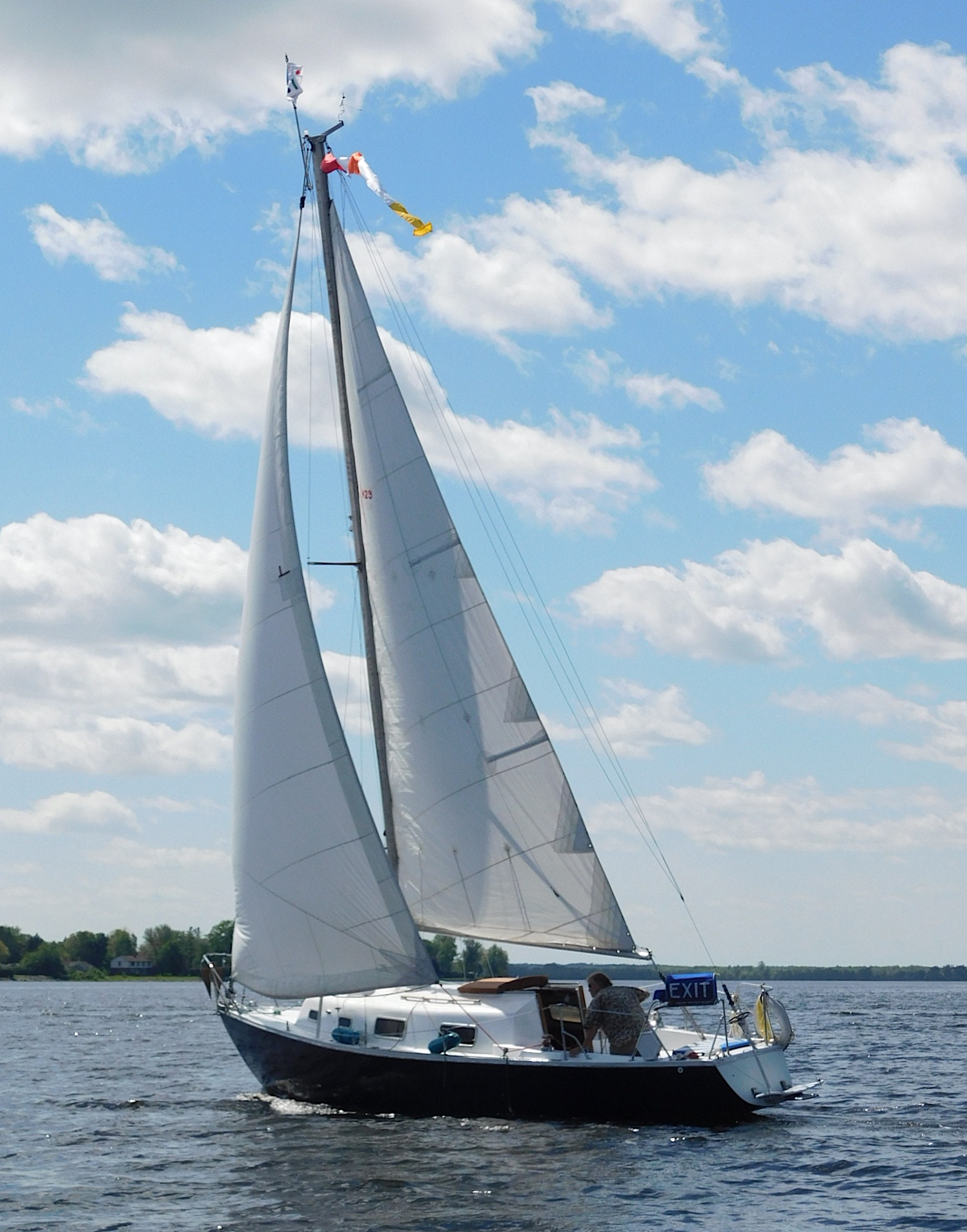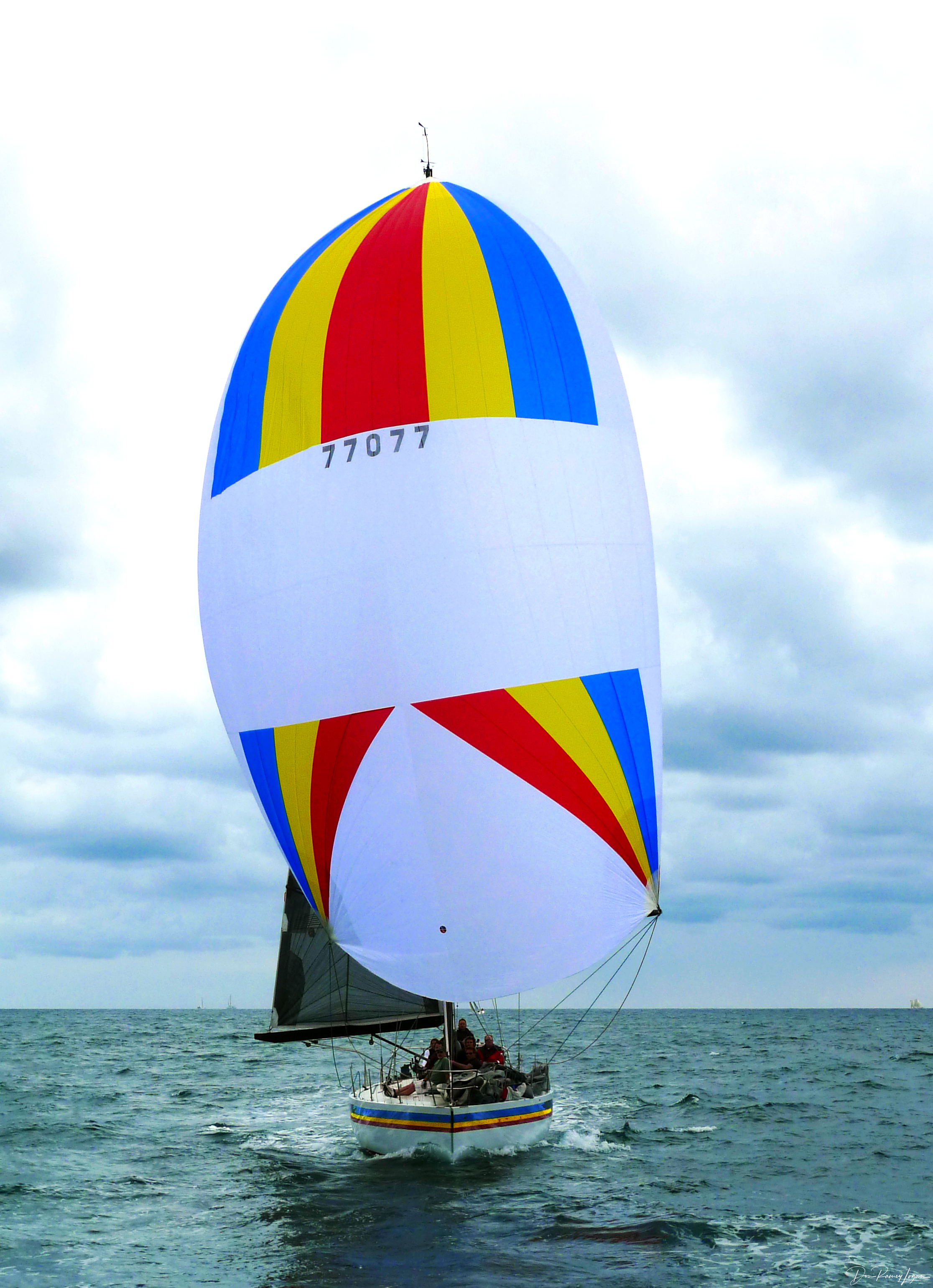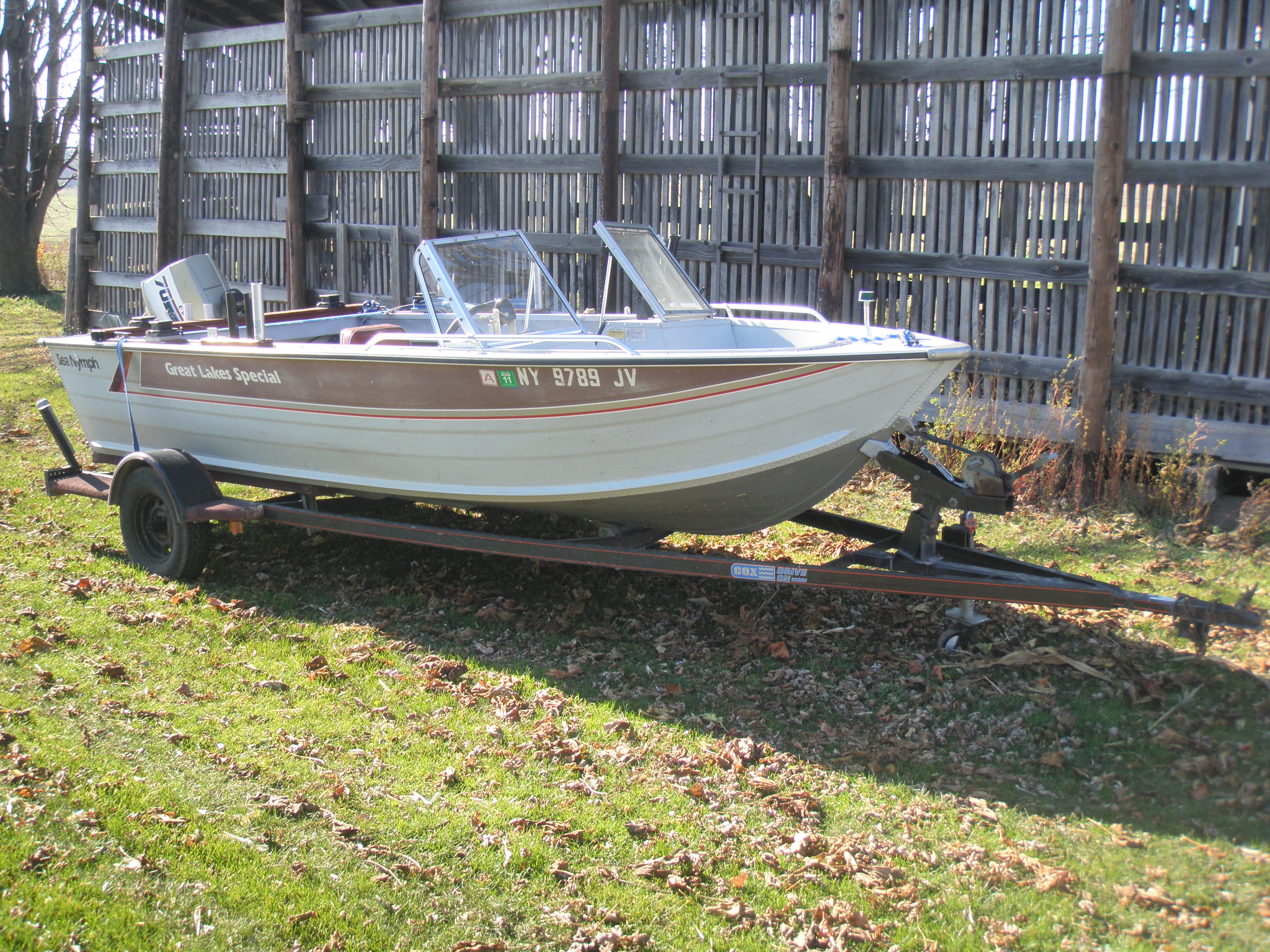|
Hughes 25
The Hughes 25 is a Canadian trailerable sailboat that was designed by Howard Hughes as a cruiser and first built in 1968. The Hughes 25 is most likely a development of William Shaw's Nutmeg 24 design. Production The Hughes 25 was built by Hughes Boat Works in Canada, starting in 1968 and proved commercially successful. It is now out of production. Design Hughes Boat Works acquired the tooling and moulds for the Nutmeg 24 from Tanzer Industries and used it to develop the Hughes 24, although it only sold in small numbers. The Hughes 25 is thought to be derived from the same design, with the addition of a fin keel, spade-type rudder and a reverse transom, but retaining Shaw's basic hull shape. The Hughes 25 is a recreational keelboat, built predominantly of fibreglass, with wood trim. It has a masthead sloop rig, a spooned raked stem, a reverse transom, an internally mounted spade-type rudder controlled by a tiller and a fixed fin keel. It displaces and carries ... [...More Info...] [...Related Items...] OR: [Wikipedia] [Google] [Baidu] |
Howard Hughes (naval Architect)
Hughes Boat Works was a Canadian boat builder based in Centralia, Ontario. The company specialized in the design and manufacture of fibreglass sailboats. The company was founded by brothers Howard and Peter Hughes in 1963 and closed in 1991. Howard Hughes was not the American pilot and engineer of the same name. The company grew to become the largest sailboat manufacturer in Canada. The company was also known as North Star Yachts Limited and later, Hughes Boatworks Inc. History The Hughes brothers formed the company initially in Willowdale, Ontario, as a builder of dinghies. Two years later, in 1965, the company was relocated to Scarborough, Ontario where they built the Hughes 24 keelboat between 1965 and 1967. The Hughes 24 used tooling and moulds purchased from Tanzer Industries. Also built during this period were the Hughes 27 and Hughes 38-1. The former was a Howard Hughes design while the latter was designed by Sparkman & Stephens in conjunction with Hughes. I ... [...More Info...] [...Related Items...] OR: [Wikipedia] [Google] [Baidu] |
Keel
The keel is the bottom-most longitudinal structural element on a vessel. On some sailboats, it may have a hydrodynamic and counterbalancing purpose, as well. As the laying down of the keel is the initial step in the construction of a ship, in British and American shipbuilding traditions the construction is dated from this event. Etymology The word "keel" comes from Old English , Old Norse , = "ship" or "keel". It has the distinction of being regarded by some scholars as the first word in the English language recorded in writing, having been recorded by Gildas in his 6th century Latin work '' De Excidio et Conquestu Britanniae'', under the spelling ''cyulae'' (he was referring to the three ships that the Saxons first arrived in). is the Latin word for "keel" and is the origin of the term careen (to clean a keel and the hull in general, often by rolling the ship on its side). An example of this use is Careening Cove, a suburb of Sydney, Australia, where careening was carried ... [...More Info...] [...Related Items...] OR: [Wikipedia] [Google] [Baidu] |
List Of Sailing Boat Types
The following is a partial list of sailboat types and sailing classes, including keelboats, dinghies and multihull ( catamarans and trimarans). Olympic classes World Sailing Classes Historically known as the IYRU (International Yacht Racing Union), the organization evolved into the ISAF (International Sailing Federation) in 1996, and as of December 2015 is now World Sailing. Dinghies Keelboats & yachts Multihulls Boards Radio-controlled Former World Sailing-classes Dinghies Keelboats & yachts Multihulls Boards Other classes and sailboat types Dinghies Keelboats & yachts Multihulls See also * Classic dinghy classes * List of boat types * List of historical ship types * List of keelboat classes designed before 1970 * Olympic sailing classes * Small-craft sailing * Clansman 30 Notes References {{DEFAULTSORT:Sailing boat types Types * Boat types A boat is a watercraft of a large range of types and sizes, but ge ... [...More Info...] [...Related Items...] OR: [Wikipedia] [Google] [Baidu] |
Hull Speed
Hull speed or displacement speed is the speed at which the wavelength of a vessel's bow wave is equal to the waterline length of the vessel. As boat speed increases from rest, the wavelength of the bow wave increases, and usually its crest-to-trough dimension (height) increases as well. When hull speed is exceeded, a vessel in displacement mode will appear to be climbing up the back of its bow wave. From a technical perspective, at hull speed the bow and stern waves interfere constructively, creating relatively large waves, and thus a relatively large value of wave drag. Ship drag for a displacement hull increases smoothly with speed as hull speed is approached and exceeded, often with no noticeable inflection at hull speed. The concept of hull speed is not used in modern naval architecture, where considerations of speed/length ratio or Froude number are considered more helpful. Background As a ship moves in the water, it creates standing waves that oppose its movement. T ... [...More Info...] [...Related Items...] OR: [Wikipedia] [Google] [Baidu] |
Spinnaker
A spinnaker is a sail designed specifically for sailing off the wind on courses between a reach (wind at 90° to the course) to downwind (course in the same direction as the wind). Spinnakers are constructed of lightweight fabric, usually nylon, and are often brightly colored. They may be designed to perform best as either a reaching or a running spinnaker, by the shaping of the panels and seams. They are attached at only three points and said to be ''flown''. Nomenclature Informal names for a spinnaker are ''kite'' or ''chute'' (owing to their resemblance to a parachute in both construction and appearance). Boats may have more than one spinnaker, differentiated by a letter to indicate symmetric (S) or asymmetric (A) and a number to indicate size (with higher numbers indicating smaller size), e.g. ''A1'' would be a large asymmetric sail and ''S3'' would be a smaller symmetric sail. Operation A spinnaker is used for sailing with the direction of the wind. Symmetrical ... [...More Info...] [...Related Items...] OR: [Wikipedia] [Google] [Baidu] |
Head (watercraft)
The head (pl. heads) is a ship's toilet. The name derives from sailing ships in which the toilet area for the regular sailors was placed at the head or bow of the ship. Design In sailing ships, the toilet was placed in the bow somewhat above the water line with vents or slots cut near the floor level allowing normal wave action to wash out the facility. Only the captain had a private toilet near his quarters, at the stern of the ship in the quarter gallery. The plans of 18th-century naval ships do not reveal the construction of toilet facilities when the ships were first built. The Journal of Aaron Thomas aboard HMS ''Lapwing'' in the Caribbean Sea in the 1790s records that a canvas tube was attached, presumably by the ship's sailmaker, to a superstructure beside the bowsprit near the figurehead, ending just above the normal waterline. In many modern boats, the heads look similar to seated flush toilets but use a system of valves and pumps that brings sea water into the toi ... [...More Info...] [...Related Items...] OR: [Wikipedia] [Google] [Baidu] |
Companionway
In the architecture of a ship, a companion or companionway is a raised and windowed hatchway in the ship's deck (ship), deck, with a ladder leading below and the hooded entrance-hatch to the main cabins. A companionway may be secured by doors or, commonly in sailboats, ''hatch boards'' which fit in grooves in the companionway frame. This allows the lowest board to be left in place during inclement weather to minimize water infiltration. The term may be more broadly used to describe any ladder between decks. File:Hatchboards.JPG, Set of hatch boards in companionway hatch. File:Hatchboards2.JPG, Set of hatch boards with top board removed. See also Glossary of nautical terms References {{sailing ship elements Rooms Water transport Nautical terminology ... [...More Info...] [...Related Items...] OR: [Wikipedia] [Google] [Baidu] |
Galley (kitchen)
The galley is the compartment of a ship, train, or aircraft where food is cooked and prepared. It can also refer to a land-based kitchen on a naval base, or, from a kitchen design point of view, to a straight design of the kitchen layout. Ship's cooking area A galley is the cooking area aboard a vessel, usually laid out in an efficient typical style with longitudinal units and overhead cabinets. This makes the best use of the usually limited space aboard ships. It also caters for the rolling and heaving nature of ships, making them more resistant to the effects of the movement of the ship. For this reason galley stoves are often gimballed, so that the liquid in pans does not spill out. They are also commonly equipped with bars, preventing the cook from falling against the hot stove. A small cooking area on deck was called a caboose or ''camboose'', originating from the nl, kombuis, which is still in use today. In English it is a defunct term used only for a cooking area that i ... [...More Info...] [...Related Items...] OR: [Wikipedia] [Google] [Baidu] |
Quarter Berth
A berth is a bed or sleeping accommodation on vehicles. Space accommodations have contributed to certain common design elements of berths. Beds in boats or ships While beds on large ships are little different from those on shore, the lack of space on smaller yachts means that bunks must be fit in wherever possible. Some of these berths have specific names: ;V-berth: Frequently yachts have a bed in the extreme forward end of the hull (usually in a separate cabin called the forepeak). Because of the shape of the hull this bed is basically triangular, though most also have a triangular notch cut out of the middle of the aft end, splitting it partially into two separate beds and making it more of a V shape, hence the name. This notch can usually be filled in with a detachable board and cushion, creating something more like a double bed (though with drastically reduced space for the feet; 12" wide is typical). The term "V-berth" is not widely used in the UK, instead the cabin ... [...More Info...] [...Related Items...] OR: [Wikipedia] [Google] [Baidu] |
"V"-berth
A berth is a bed or sleeping accommodation on vehicles. Space accommodations have contributed to certain common design elements of berths. Beds in boats or ships While beds on large ships are little different from those on shore, the lack of space on smaller yachts means that bunks must be fit in wherever possible. Some of these berths have specific names: ;V-berth: Frequently yachts have a bed in the extreme forward end of the hull (usually in a separate cabin called the forepeak). Because of the shape of the hull this bed is basically triangular, though most also have a triangular notch cut out of the middle of the aft end, splitting it partially into two separate beds and making it more of a V shape, hence the name. This notch can usually be filled in with a detachable board and cushion, creating something more like a double bed (though with drastically reduced space for the feet; 12" wide is typical). The term "V-berth" is not widely used in the UK, instead the cabin a ... [...More Info...] [...Related Items...] OR: [Wikipedia] [Google] [Baidu] |
Boat Trailer
A boat trailer is designed to launch, retrieve, carry and sometimes store boats. Commercial boat trailers Commercial hydraulic boat trailers are used by marinas, boat yards, boat haulers, boat dealers and boat builders. Generally this type of trailer is not used for storage of the boat. Self-propelled Self-propelled boat movers are not strictly trailers, but hydraulically operated boat movers, with their own tractor unit. They share all of the features of hydraulic boat trailers. Non-commercial boat trailers This type of trailer is usually used by the boat owner/operator. The trailer is also used for storage. * Roll-on, also known as a "Roller style trailer", uses rubber and/or polyurethane rollers for ease of launching and loading a boat. * Glide-path, also known as a "Float-on style trailer", allows the boat to float onto the trailer; after the trailer has been partially submerged (usually of the trailer). Since its inception, it has become quite popular compared to the ... [...More Info...] [...Related Items...] OR: [Wikipedia] [Google] [Baidu] |
Tiller
A tiller or till is a lever used to steer a vehicle. The mechanism is primarily used in watercraft, where it is attached to an outboard motor, rudder post or stock to provide leverage in the form of torque for the helmsman to turn the rudder. A tiller may also be used in vehicles outside of water, and was seen in early automobiles. On vessels, a tiller can be used by the helmsman directly pulling or pushing it, but it may also be moved remotely using tiller lines or a ship's wheel. Rapid or excessive movement of the tiller results in an increase in drag and will result in braking or slowing the boat. Description A tiller is a lever used to steer a vehicle. It provides leverage in the form of torque to turn the device that changes the direction of the vehicle, such as a rudder on a watercraft or the surface wheels on a wheeled vehicle. A tiller can be used by directly pulling or pushing it, but it may also be moved remotely using tiller lines or a ship's wheel; some kay ... [...More Info...] [...Related Items...] OR: [Wikipedia] [Google] [Baidu] |







_bunks.jpg)
